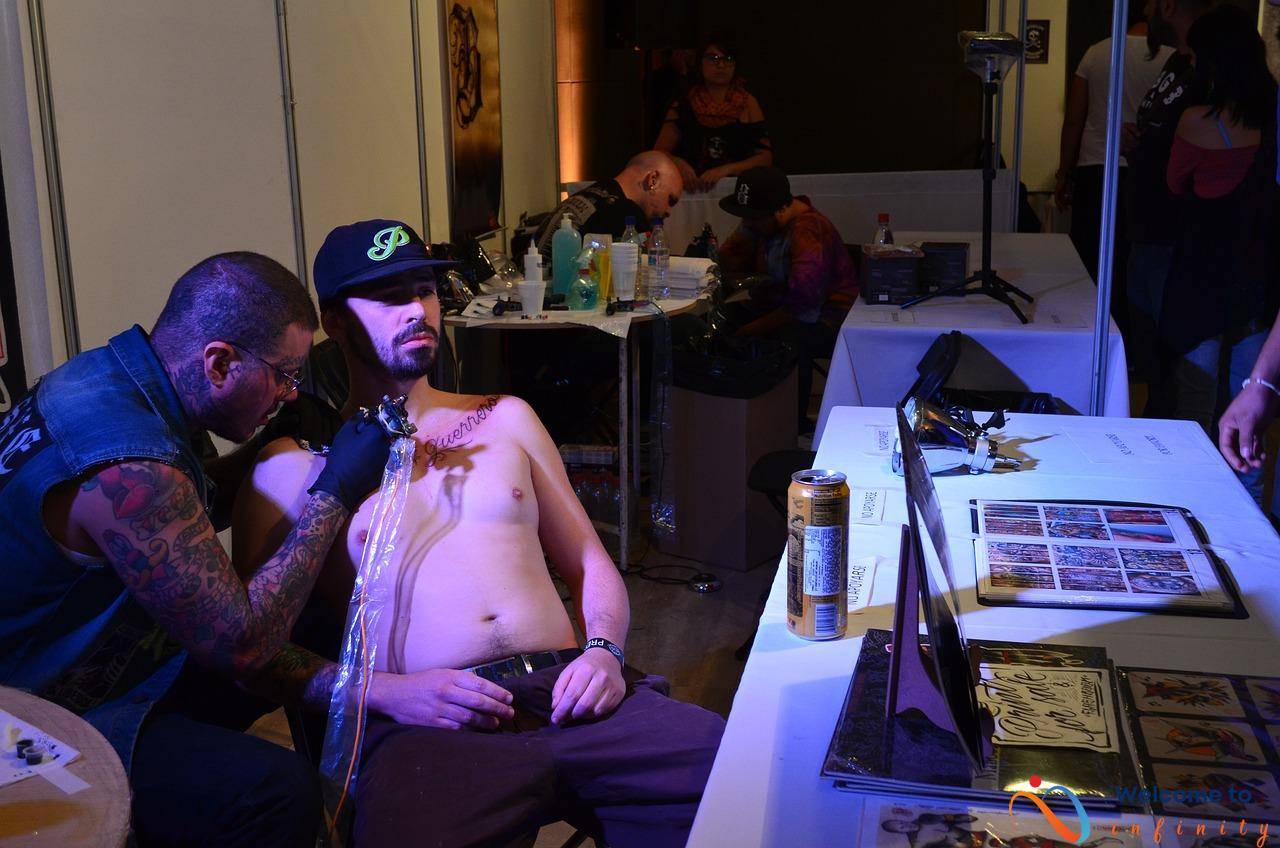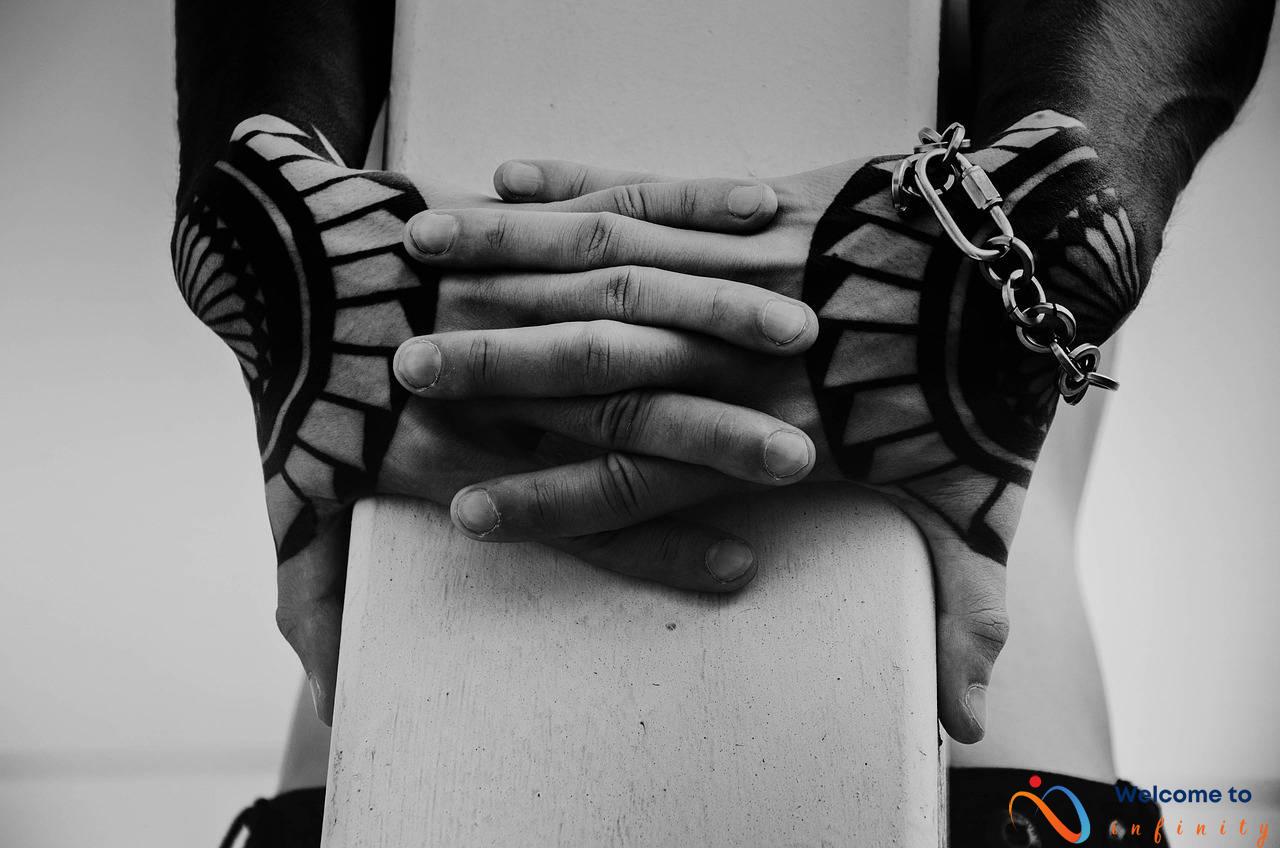Hand-poked tattoos, also known as stick-and-poke tattoos, have been around for thousands of years and have been the primary mode of inking throughout history. This traditional technique originated in countries like Japan, Thailand, and Polynesia, where it was used to signify social status, rank, and tribe membership.
Despite the invention of electric tattoo machines, hand-poked tattoos have recently resurfaced in the modern world as people seek a more authentic and intimate experience with their tattoo artist. This trend has come about because hand-poking allows for more creative freedom and a unique aesthetic that differs from electric tattoos.
Many tattoo enthusiasts are drawn to hand-poked tattoos because of the intimate and authentic experience that it offers. This is because hand-poking allows for a personal connection to be established between the artist and the client, which is key to creating a meaningful and unique design.
History of Hand-Poked Tattoos
Hand-poked tattooing has been practiced by various cultures for thousands of years, making it one of the oldest forms of tattooing. Its origins can be traced back to ancient civilizations in countries like Japan, Thailand, and Polynesia. For these cultures, tattoos were not only considered a form of adornment but also had ritualistic and spiritual significance.
In Japan, hand-poking was known as tebori and was primarily used for creating full-body tattoos that were associated with the yakuza (Japanese mafia). In Polynesia, hand-poking was used to create intricate tribal designs that marked social status and served as a form of identification.
As hand-poking spread to other parts of the world, its significance and meaning evolved along with it. In the Western world, hand-poked tattoos became associated with counterculture movements like punk and DIY culture.
Today, hand-poked tattoos have become more popular as people seek a more authentic and intimate experience with their tattoo artist. With its rich history and cultural significance, hand-poking has become a revered art form that continues to inspire and influence tattoo culture around the world.
Techniques Used in Hand-Poked Tattoos
Hand-poking tattoos is a time-consuming process that requires a steady hand and a lot of patience. Unlike electric tattooing machines that utilize a needle to quickly puncture the skin, hand-poking relies solely on manual tools to create intricate designs.
There are two main techniques used in hand-poking tattoos: stick-and-poke and tebori.
Stick-and-poke is one of the oldest forms of hand-poking tattoos. A sharp needle is dipped in ink and repeatedly poked into the skin in the desired pattern. This technique is more time-consuming and requires artists to take many breaks to refill the needle with ink. It also requires more skill and precision than an electric tattoo machine.
Some people prefer stick-and-poke tattoos because it creates a soft, hand-drawn aesthetic that is not possible with an electric machine. However, it also poses certain risks, like scarring and infection, that should be considered before getting a stick-and-poke tattoo.
While stick-and-poke is a traditional technique of tattooing, it is still important to remember safety measures that tattoo artists need to take to protect themselves and their clients. They need to use new needles every time and protect the skin from infection by following hygiene protocols. Ink also needs to be high-quality and fresh to avoid infections.
Tebori encompasses a wide variety of techniques, but generally, it involves using a long, slender needle that is dipped in ink and inserted into the skin with a rhythmic pricking motion. The needle depth reaches the dermis and the ink will stay there permanently.
Tebori is a traditional Japanese technique of tattooing that has been used for centuries. This technique should be performed by a highly skilled tattoo artist, who has learned it from a Japanese master. It is a very intricate technique and is also more painful than other forms of tattooing. However, the end result is often breathtaking.
Hand-Poked tattooing is an art, and different artists will have their preferred techniques and tools. As a client, it's important to research and pick out the artist that best matches your desired aesthetic. They will help guide you through the process and make it less daunting.
Stick-and-Poke
Stick-and-poke is a traditional tattooing technique that has been used for thousands of years. It differs from electric tattooing in that it relies on a sharp needle and ink that is manually poked into the skin to create designs. With stick-and-poke, the artist uses a single needle to create the design one dot at a time, giving them much more control and precision over the outcome.
One of the biggest benefits of stick-and-poke is the fact that it is less invasive than electric tattooing. With no buzzing machine, it offers a quieter and more intimate experience that many people find soothing. Additionally, it can be less painful than electric tattooing due to the smaller needle size and less trauma to the skin. However, it is important to note that this technique may require multiple sessions to complete the design, which may increase the risk of skin irritation and infection if proper aftercare is not followed.
Safety is a major consideration when it comes to stick-and-poke. It is essential that your artist follows proper sanitation procedures to reduce the risk of infection and other complications. This includes using sterile, disposable needles and ink, wearing gloves, and properly disposing of any waste materials.
- Pros of Stick-and-Poke:
- More control over design due to manual technique
- Quiet and intimate experience
- Less painful and traumatic to the skin
- Allows for precise details in designs
- Cons of Stick-and-Poke:
- May require multiple sessions to complete design
- Risk of skin irritation and infection if proper aftercare is not followed
- Important to find a qualified artist who follows proper sanitation procedures
If you're considering a stick-and-poke tattoo, it's important to do your research and find a reputable artist with experience in this technique. With proper care and attention, stick-and-poke tattoos can be a beautiful and unique addition to your body art collection.
Safety Considerations
While hand-poked tattoos are a traditional form of tattooing, there are still safety concerns that need to be addressed by tattoo artists. Safety measures need to be taken to protect the artist and the client from risks such as infection, scarring, and allergic reactions.
Here are some important safety considerations that tattoo artists need to follow:
- Using Sterilized Tools: It is critical to use sterilized tools for each client. Single-use needles, ink cups, gloves, and other tools must be opened in front of the client to ensure their cleanliness.
- Proper Sanitation: Safe tattoo practices require using a clean and sterile work environment. Tattoo artists should use gloves when in contact with the client's skin, and the tattoo station should be wiped clean with a disinfectant before and after every tattoo.
- Aftercare Instructions: Tattoo artists should provide detailed aftercare instructions to minimize the risk of infection and encourage proper healing for the client's tattoo.
- Testing for Allergies: Ink allergies are a possibility, so clients need to be tested for any allergic reactions before getting tattooed. Skin patch tests should be performed to avoid dangerous complications.
By following these safety measures, tattoo artists can reduce the risks associated with hand-poked tattoos. To ensure a safe and enjoyable tattooing experience for both the artist and the client, safety must come first.
Tebori
Tebori is a traditional style of hand-poked tattooing that originated in Japan. The technique involves using a long, slender needle, known as a tebori needle, that is dipped in ink and inserted into the skin with a rhythmic pricking motion. The needle is hand-guided, allowing for greater control and precision, resulting in intricate designs with fine details.
Tebori differs from other forms of hand-poking, like stick-and-poke, in its use of a single needle and the method of insertion. With stick-and-poke, the needle is repeatedly poked into the skin in a stippling motion to create the desired pattern. In contrast, tebori utilizes a smooth, fluid motion that results in a much more organic and natural-looking design.
The process of tebori tattooing is said to be more comfortable for the client than electric tattooing because the needle does not penetrate the skin as deeply. Additionally, the tattoos tend to heal faster and with less scarring than electric tattoos. However, because the process is more time-consuming, tebori tattoos can be more expensive.
One of the unique aspects of tebori tattooing is the importance of the relationship between the artist and the client. The process can take several sessions to complete, providing an opportunity for the artist and client to develop a close bond. In Japan, tebori tattooing is seen as a sacred art form, and the artist is often revered as a master craftsman.
In modern times, tebori has gained popularity outside of Japan as more people seek out traditional tattooing methods. Its unique style and intricate designs have made it a desirable choice for those looking for a tattoo with a more personal touch. As with any form of tattooing, it's important to find a skilled and reputable artist to ensure a safe and satisfying experience.
The Rising Popularity of Hand-Poked Tattoos
Hand-poked tattoos have experienced a resurgence in recent years, with many people opting for this traditional form of inking over electric tattoos. One of the reasons for this trend is the popularity of minimalist and small tattoos, which are more easily achieved through hand-poking.
Hand-poking also offers a more intimate and authentic experience for those getting tattoos. Unlike electric tattoo machines, hand-poking relies solely on the artist's manual tools, which allows for more creative freedom and precise detailing of intricate designs.
Another benefit of hand-poked tattoos is the uniqueness of the style and aesthetic. The slower and more deliberate process required for hand-poking allows for a greater range of subtlety and detail than electric machines. This can lead to even more personalized tattoos, tailored specifically to the individual's tastes and preferences.
Furthermore, the process of getting hand-poked tattoos can be more comfortable for some people. Electric tattoo machines can vibrate and cause discomfort or pain, which may be more acute if getting a larger or more intricate tattoo done. With stick-and-poke or tebori, the design is punctured manually, making it a less intense and more manageable experience for some clients.
The rising popularity of hand-poked tattoos is also linked to a growing interest in traditional tattoo styles from around the world. Many cultures have used similar techniques for centuries, and hand-poking allows for the continuation of these ancient traditions.
Overall, the benefits of hand-poked tattoos are clear. Those looking for a more personal and intimate experience, unique design styles, and a more enjoyable inking process are all reasons why hand-poked tattoos are gaining popularity in modern times.
Authenticity and Intimacy
Getting a tattoo is a permanent decision, so it's crucial to have a good relationship with your tattoo artist. Hand-poked tattoos allow for a more intimate experience, which builds trust and creates a personal connection between the artist and the client. Unlike electric tattoo machines that produce a buzzing noise, the sound of a hand-poked tattoo is more subtle, which encourages a calm and relaxing atmosphere.
The artist's hands are also closer to the skin, which allows them to feel the muscle movement and depth of the needle within the skin. This enables the artist to create a design that best fits the client's body and enhances the overall aesthetic appeal.
- In conclusion, personal connections are essential when getting a tattoo. Hand-poked tattoos offer an intimate and authentic experience that builds trust and creates a more personalized design. If you're looking for a unique and meaningful tattoo that connects you with your artist on a deeper level, consider going for a hand-poked tattoo.
Unique Style and Aesthetic
Hand-poked tattoos have a unique style and aesthetic that differs from electric tattoos. The manual tools used in hand-poking provide more creative freedom and allow for intricate designs that cannot be achieved with an electric machine. The process of hand-poking, with its slower and more deliberate approach, creates a different type of tattooing experience.
Compared to electric tattoos, hand-poked tattoos have a softer and more organic feel to them. The ink is hand-delivered into the skin, allowing for a more natural and varied result. The thickness and saturation of the lines can be controlled more precisely, resulting in a more personalized and unique piece of art.
Hand-poked tattoos also have a more intimate feel to them. The process of hand-poking takes longer than using an electric machine, which allows the artist and client to build a more personal relationship. The artist's touch is more evident, creating a deeper connection between the tattoo and the person receiving it.
The unique style and aesthetic of hand-poked tattoos have made them a popular choice for those seeking a more personal and authentic tattoo experience. Whether it's the softer, more organic feel of the tattoo or the deeper connection between the artist and client, hand-poked tattoos offer a unique and beautiful form of body art.
Final Thoughts
Hand-poked tattoos have been around for centuries, and with their recent resurgence in popularity, it's important to understand the significance of this traditional form of tattooing. While electric tattoo machines are the go-to choice for most tattoo artists, hand-poking offers a unique and intimate experience for both the artist and the client.
Hand-poking offers more creative freedom and allows for intricate designs, making it an attractive option for those seeking a unique and personalized tattoo. Additionally, the process of hand-poking creates a bond between the artist and the client, leading to a more authentic and meaningful experience.
As hand-poked tattoos continue to rise in popularity, it's crucial for tattoo artists and enthusiasts to understand the history and techniques behind this traditional form of tattooing. By doing so, we can appreciate the artistry and significance of hand-poking in modern tattoo culture.
In conclusion, hand-poked tattoos are a testament to the beauty and artistry of traditional techniques in modern times. Its rising popularity speaks to the desire for authenticity, creative freedom, and intimacy in the art of tattooing.









